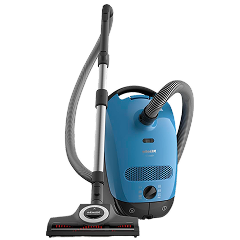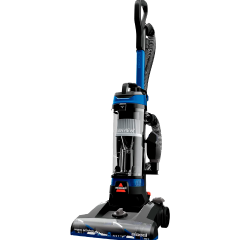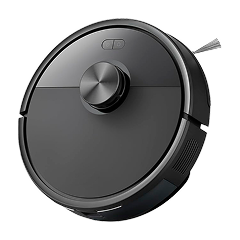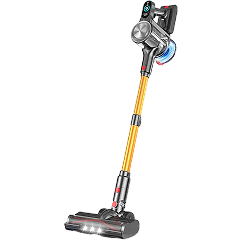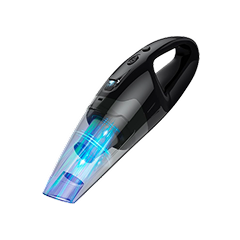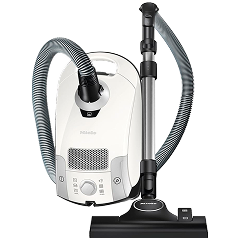When most people think of a vacuum cleaner, an upright model comes to mind. There’s a reason they’ve been in production for almost a century. The ergonomics of an upright vacuum make it one of the most effort-efficient designs to clean a large floor. If you’ve been frustrated in the past by a vacuum, here’s what I think you need to know in order to pick the perfect upright vacuum for you.
I’ve been testing and writing about vacuums for over a decade. We’re going to cover what makes a good upright vacuum, what kind of features are out there, and what you can expect from the best-selling brands.
How to Choose the Right Upright Vacuum
Does weight matter?
Weight is a nuanced matter when it comes to vacuums. For the vast majority of people, lighter is better. A heavier vacuum does not mean better quality, higher suction, or a more durable product. And a vacuum that tips the scale harder will be more difficult to push, more fatiguing to carry up stairs, and generally make you want to use it less.
The one exception that comes to mind are Miele vacuums. Some models this brand produces have weights placed inside the chassis of its uprights. These are meant to increase stability so they are less likely to be knocked over or fall over when in use.
If you’re cleaning multiple floors, you should look for an upright that has handles on the back that will help distribute the weight better to make it easier to carry up the stairs.
Cleaning power
Cleaning power is an important metric for a vacuum, but it can be complicated and vague. There are two categories that measure a vacuum’s motor: suction and wattage.
Wattage is the flow of electricity over time. So a 1,000-watt motor draws more power than a 100-watt motor. It also means that a 1,000-watt motor has more cleaning potential than a weaker motor, but that it’s not a seamless translation. Imagine a car with a powerful motor. A powerful motor creates the potential for a very high top speed. However, if all the tires are flat, you’re not going to get anywhere fast.
The same is true for a vacuum. A powerful motor needs to be paired with a well-sealed chassis to prevent leakage, a well-designed brush head for dirt pick up, and a clean filter to assure air flow. When all these aspects line up, you get a strong partial vacuum, also known as suction.
For uprights, canisters, and some cordless vacuums, that suction is measured in air watts. Air Watts are calculated by multiplying suction power by airflow and dividing that number by 8.5.
For an upright vacuum, an air watt rating between 100-290 AW and above 1,000 watts is probably going to get the job done.
Cord length
Cord length is important because it translates to the maximum reach of your vacuum. When you consider cord length, think about the layout of your home and where the outlets are. You don’t want to be caught in a situation where you have a dead zone where your vacuum can’t reach.
Filter types
The most common type of filter is the High-Efficiency Particulate Air or HEPA filter. These are filters that are made from fiberglass, and they strain out small particulates from the air. To be called HEPA, a filter must be able to remove at least 99.97% of particulates greater than .3 microns in diameter. There are several grades higher than that, but this is the minimum.
You may encounter a vacuum that claims to have HEPA-like filters. These are filters that are similar, but don’t meet HEPA standards.
Vacuum brands like Shark also include additional pre-filters. These are foam and mesh filters designed to keep larger particulates like hair from clogging the more expensive HEPA filter, so you can get more use out of it. Pre-filters are often washable.
There are also lines like SEBO, which have electrostatic filters that charge the air with ions to attract very fine dust like a magnet.
Changing out your vacuum’s filters regularly will help maintain the longevity of the device.
Anyone who’s interested in increasing the air quality in their home and making sure their vacuum doesn’t put dust back into the air, a certified HEPA filter is the gold standard.
Bagged vs Bagless
The trade-off between bagged and bagless comes down to hygiene versus convenience. The bag itself acts as an additional layer of filtration. Some bagless models compensate by including an additional filter, usually made from mesh or foam.
Bagged vacuums are also more hygienic when it comes to emptying. When you toss the dirt bag away, it won’t cause a dust plume that you get when you open the dirt container of a bagless vacuum. There’s also the added benefit if you’re the type of person who doesn’t like to see, touch, or smell anything unpleasant; the bag helps conceal all that from you.
Bagged vacuums have larger dirt capacities than bagless vacuums. That means emptying less often. However, the consequence of that is that bagged vacuums can get a certain bad odor from the dirt, dust, crumbs, and hair sitting in the bag for months at a time. Dirt cups can also develop that smell, but you can also wash them.
Bagless vacuums also have the advantage of peace of mind, of never having to worry about finding compatible bags. Also, some people really like having a view of all the dirt their vacuum suctioned up.
Dustbin capacity
Dustbin or bag capacity refers to how much dirt and debris you can vacuum before you need to change the bag or empty the dustbin.
- For bagged uprights, you can expect a capacity of between 3-5 liters or .8-1.5 gallons.
- Bagless models tend to have a lower capacity. For those, they average between 1-3 liters or .25-1.5 gallons.
Noise Level
Vacuum cleaners are noisy. It’s common for a full-sized vacuum to make 72 dBA during operation, which is loud enough to drown out a normal conversation. There are vacuums that have Quiet Modes, which are usually just a reduction in power to the motor. If a vacuum has different cleaning modes, a lighter one will usually reduce the noise it makes.
Brushroll Types
There is also the question of what the brush head is made of. The best brush heads tend to be made of a combination of fluffy and stiff bristles. The fluffy material, usually nylon, is great at removing fine dust that adheres to hardwood. Imagine a mechanized dusting cloth. The stiffer bristles act more like a broom to sweep up larger debris and beat dust out of carpets.
On the more niche front, there are brush heads that are designed to resist hair tangles. This is great for people with pets or a household where one or more members have long hair. And the specialized features don’t stop at the brush head.
Ease of cleaning
For manual vacuums, the ease of cleaning usually boils down to the synergy between the motor and the brush roll, swivel joints, and the placement of the handles.
When a vacuum’s motor works well with the brush roll, you get the feeling that the unit is self-propelled. Motors with higher wattages are more likely to have this effect.
Vacuums that advertise swivel or ball joints are also going to be easier to clean with. These joints allow the vacuum to twist and turn on a dime in order to clean around corners and furniture better.
Special Features Upright Vacuum Cleaners Can Have
LED lights and dirt detection
Many upright vacuums come with LED lights on the main brush head. This can help you spot dust bunnies in dark places, such as under the couch. Higher-end models also might come with a dirt detection sensor. Some models have a light that tells you if the sensors detect dirt, while others even have a screen that displays what the vacuum is picking up.
Lift-away
One major issue that upright vacuums suffer from is that they are hard to carry. There are upright vacuums that can detach from their base and transform into a wheelless canister. This feature allows you to more easily clean stairs and tight spaces like car seats.
Swivel joints
If you live in a home with a lot of furniture or tight corners, you should check out an upright with a swivel joint. They come in different shapes and sizes, but they will allow you to maneuver your vacuum more easily.
Upright Vacuum Cleaner Brands & What to Expect
Shark
Shark makes some really good general crowd pleasers. They are stuffed to the rafters with features. One that has stood the test of time is the lift-away model. The most popular Shark uprights can detach from their brush heads to become a wheelless canister.
Shark vacuums also tend to come with a full set of attachments and washable prefilters.
The final point in Shark’s favor is that the company covers its models with a robust five-year warranty.
In my experience, Shark is very responsive to consumer wants, so popular models stay in stock while those that don’t sell well disappear very quickly. The company’s manufacturing base is robust, so parts also always seem available. When you use a Shark vacuum, especially the higher-end ones, you’re going to constantly come across features that make you go, “that’s clever”.
Miele
Meile is a legacy brand with a commitment to quality and innovation. It has the motto “Immer Besser” or Forever Better. The company’s uprights and canisters are the stars of the lineup. There are a few models of robot vacuums and cordless vacuums, but they are somewhat underwhelming.
What sets Miele’s uprights and canisters apart is the craftsmanship. All the seams, screws, and buttons, received human attention during quality control. When you use a Miele vacuum, everything feels solid and well put together.
If you’ve ever felt frustrated by your upright tipping over when using the hose attachments, Miele solved this problem by adding weights to ensure stability. The canisters often have a ton of built-in cleaning modes like Quiet Mode and a Drapes setting, so you don’t need to play a guessing game when cleaning.
Overall, my experience testing Miele vacuums makes me think they are well worth the investment. However, they are expensive, and the selection is increasingly getting narrower. When I first started testing Miele vacuums ten years ago, there were significantly more models and packages. So if you saw a model in the past you wanted to check out again, it’s likely gone from the retail market.
Bissell
If you’re looking for an affordable upright vacuum, you should check out Bissell. The company makes vacuums that are perfect for people who just want one that’s “good enough”. Bissell’s vacuums tend to be bulky and powerful, with a few nice-to-have features sprinkled in.
For example, there are Bissells with a large one-liter dust bin, excels at cleaning pet hair, and a 27-foot cord that automatically retracts. It’s also very loud and won’t be able to clean under your tables easily.
Also, odds are if you get a Bissell upright, be sure to have a screwdriver when you unpack it. The handle will likely be secured by two screws and there will always be a little bit of jiggle.
Common Mistakes When Purchasing an Upright Vacuum Cleaner
Not making sure you can get it up the stairs
People who are elderly or have mobility issues should make sure that they can lift their vacuum to where it needs to go.
Failing to get a vacuum with the appropriate brush head
Brush heads come with different types of bristles. Some specialize in cleaning hardwood without scratching it, while others are geared toward thick carpets. Getting the right one will help make sure your floors get clean.
Getting one with the wrong dirt capacity
If you don’t vacuum very frequently, you might want to get a vacuum with a lower dust capacity, forcing you to empty it more often. Not emptying your vacuum often enough can cause malodor.


